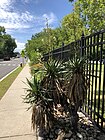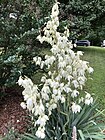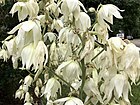Note: This is a project under development. The articles on this wiki are just being initiated and broadly incomplete. You can Help creating new pages.
Yucca filamentosa
Yucca filamentosa is an evergreen shrub producing a rosette of spear-shaped leaves 50 - 75cm long and 2 - 4cm wide from a long, thick, mainly underground stem with a very short, unbranched, above-ground stem up to 50cm tall. The plant forms a cluster of rosettes plus one or more flowering stems up to 4.5 metres tall.
Contents
[hide]- 1 Uses
- 2 Parts Used
- 3 Chemical Composition
- 4 Common names
- 5 Properties
- 6 Habit
- 7 Identification
- 8 List of Ayurvedic medicine in which the herb is used
- 9 Where to get the saplings
- 10 Mode of Propagation
- 11 How to plant/cultivate
- 12 Commonly seen growing in areas
- 13 Photo Gallery
- 14 References
- 15 External Links
Uses
Low blood pressure, Osteoarthritis, Swelling, Hypertension, Migraine headaches, Colitis, Stomach disorders, Hypercholesterolemia, Diabetes, Poor circulation, Gallbladder disorders.
Parts Used
Fruits, Flowers, Flowering stem.
Chemical Composition
It contains phenolic constituents of Y. schidigera etc.[1]
Common names
| Language | Common name |
|---|---|
| Kannada | |
| Hindi | |
| Malayalam | |
| Tamil | |
| Telugu | |
| Marathi | |
| Gujarathi | |
| Punjabi | |
| Kashmiri | |
| Sanskrit | |
| English |
Properties
Reference: Dravya - Substance, Rasa - Taste, Guna - Qualities, Veerya - Potency, Vipaka - Post-digesion effect, Karma - Pharmacological activity, Prabhava - Therepeutics.
Dravya
Rasa
Guna
Veerya
Vipaka
Karma
Prabhava
Habit
Identification
Leaf
| Kind | Shape | Feature |
|---|---|---|
Flower
| Type | Size | Color and composition | Stamen | More information |
|---|---|---|---|---|
| {{{5}}} |
Fruit
| Type | Size | Mass | Appearance | Seeds | More information |
|---|---|---|---|---|---|
Other features
List of Ayurvedic medicine in which the herb is used
Where to get the saplings
Mode of Propagation
How to plant/cultivate
Yucca filamentosa is a plant of semi-arid regions in southern N. America and can tolerate occasional short-lived temperatures down to around -15°c.[3]
Commonly seen growing in areas
Sand dunes, Waste ground, Pine forests along the coastal plain.
Photo Gallery
References
- Jump up ↑ Chemical constituents
- Jump up ↑ [Morphology]
- Jump up ↑ Cultivation
External Links
- Ayurvedic Herbs known to be helpful to treat Low blood pressure
- Ayurvedic Herbs known to be helpful to treat Osteoarthritis
- Ayurvedic Herbs known to be helpful to treat Swelling
- Ayurvedic Herbs known to be helpful to treat Hypertension
- Ayurvedic Herbs known to be helpful to treat Migraine headaches
- Ayurvedic Herbs known to be helpful to treat Colitis
- Ayurvedic Herbs known to be helpful to treat Stomach disorders
- Ayurvedic Herbs known to be helpful to treat Hypercholesterolemia
- Ayurvedic Herbs known to be helpful to treat Diabetes
- Ayurvedic Herbs known to be helpful to treat Poor circulation
- Ayurvedic Herbs known to be helpful to treat Gallbladder disorders
- Herbs with Fruits used in medicine
- Herbs with Flowers used in medicine
- Herbs with Flowering stem used in medicine
- Habit - Evergreen shrub
- Index of Plants which can be propagated by Seeds
- Herbs that are commonly seen in the region of Sand dunes
- Herbs that are commonly seen in the region of Waste ground
- Herbs that are commonly seen in the region of Pine forests along the coastal plain
- Herbs





